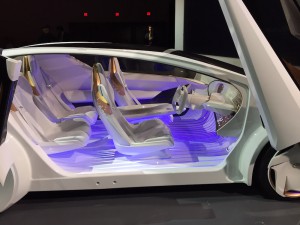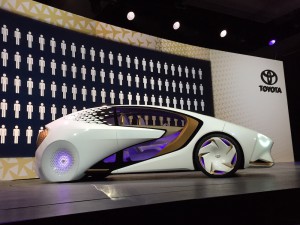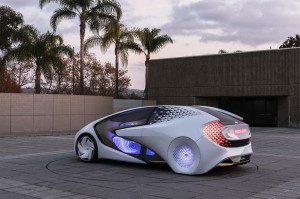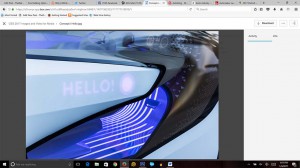
Toyota is looking to make the car of the future with all of its hardware and software a little more human. The result of that effort is the Concept-i.
Tomorrow’s car are going to be computers on wheels, with countless microprocessors, digital displays and other technologies handling safety, powertrain and infotainment systems. But getting a handle on it all can be a bit overwhelming.
So, Toyota is trying to find a way to humanize all that hardware and software with the Concept-i prototype making its debut at the CES in Las Vegas this afternoon.
The prototype is meant to “foster a warm and friendly user experience,” the automaker explains, using artificial intelligence that “learns and grows with the driver.”
The prototype was designed by Toyota’s CALTY advanced vehicle development center in Newport Beach, California, and is part of a $1 billion AI and autonomous driving program the maker announced at what was then known as the Consumer Electronics Show in January 2016.

The Concept-i prototype was designed by Toyota’s CALTY advanced vehicle development center in Newport Beach, California.
“We recognize that the important question isn’t whether future vehicles will be equipped with automated or connected technologies,” said Bob Carter, senior vice president of automotive operations for Toyota. “It is the experience of the people who engage with those vehicles. Thanks to Concept-i and the power of artificial intelligence, we think the future is a vehicle that can engage with people in return.”
Like other AI-based “digital assistants,” the software behind the Toyota Concept-i can pick up on a driver’s driving patterns and schedules. But it’s meant to learn more, even picking up on a driver’s emotions. It can then interact in different ways, depending upon “driver responsiveness,” Toyota explains.
(Toyota likely to lose global sales crown. Click Here for the details.)
The vehicle itself can be operated in autonomous mode or driven manually – or somewhere in-between. The AI system monitors the driver’s awareness, for example, as well as things like road conditions. If necessary, it can step in “to help navigate dangerous driving conditions.”
The technology is wrapped around an AI Agent, much like an iPhone’s Siri, but here picking up the distinctly Japanese name, Yui.
Yui, the carmaker explains, “is designed to communicate across cultures to a global audience. With Yui’s home centered on the dashboard, Concept-i’s interior emanates around the driver and passenger side and throughout the vehicle in sweeping lines, with interior shapes designed to enhance Yui’s ability to use light, sound and even touch to communicate critical information.”
A look inside reveals that the Toyota Concept-i breaks from what many new high-tech vehicles are doing, opting for fewer, rather than more video screens. Instead, the system uses a variety of different ways to communicate with the driver. Lights in the footwell, for example, reveal whether the vehicle is operating in manual or autonomous mode.
(Click Here for more about how the connected car industry will grow to $130B by 2019.)
Projectors discretely present views on the window pillars to warn about blind spots. There’s also a head-up display so the driver’s eyes don’t have to wander away from the road.
The Concept-i also communicates with those outside the vehicle. Displays built into the door panels greet those approaching the concept car. The front display tells pedestrians and oncoming motorists whether the vehicle is operating in manual or autonomous mode, and a rear display warns other drivers about turns and possible hazards.
Toyota says the Concept-i is more than another fantasy show car. It says it plans to test the prototype on public roads in Japan in a few years. Some of the technologies could then make it into production.
Toyota isn’t the only one exploring these interactive concepts. The FF91 supercar unveiled at CES by Faraday Future on Tuesday also included an AI system designed to learn about drivers and occupants, not only using that information to plan routes but also to adjust settings, even offer them their favorite music or videos. And it features outside lighting that also can communicate with pedestrians and other motorists.
(Autonomous cars, battery vehicles and record sales: a look at 2016′s top stories. For more, Click Here.)
Such concepts may become even more common in the future, especially as autonomous and fully driverless vehicles become commonplace.


